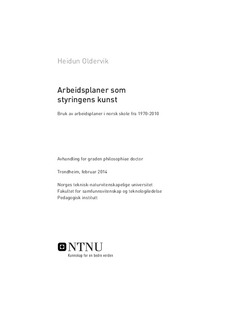| dc.contributor.author | Oldervik, Heidun | nb_NO |
| dc.date.accessioned | 2014-12-19T14:39:34Z | |
| dc.date.available | 2014-12-19T14:39:34Z | |
| dc.date.created | 2014-03-20 | nb_NO |
| dc.date.issued | 2014 | nb_NO |
| dc.identifier | 706463 | nb_NO |
| dc.identifier.isbn | 978-82-326-0078-6 (trykt utg.) | nb_NO |
| dc.identifier.isbn | 978-82-326-0079-3 (elektr. utg.) | nb_NO |
| dc.identifier.uri | http://hdl.handle.net/11250/269854 | |
| dc.description.abstract | The use of pupils’ work-plans in Norwegian elementary school is a wide-spread contemporary educational practice. It has been perceived as initiated by teachers and schools, and not promoted by official policies. This is the background for my exploration of the use of work-plans as a tool of governance, where Foucault’s concept of governmentality, further elaborated by Dean (1999), provides the analytical framework for my study. In this study I have used a range of sources. I have been doing interviews with key-informants involved in policy-making from the 70’s and onwards, and with teachers and principals at schools involved in teaching-innovations and projects. Other sources are government policy documents, instructional material for teachers and samples of teaching material and work-plans from different time-periods. My research also includes a contemporary classroom study in 6th grade, using ethnographical methods.
Exploring the historical emergence of pupils’ work-plans, I find that it took place in the context of progressive schools in the 70’s. Governing discourses suggested participation, freedom and responsibility for schools, teachers and pupils. The teacher at that period of time faced new challenges meeting the individual child’s needs in heterogenous classes. The work-plans were to some extent negotiated between teacher and pupil, and its personal and short term planning gave room for flexibility and variation in learning activities. Nevertheless it was meticulous training towards autonomy and responsibility. The use of work-plans was promoted through some of Grunnskolerådets projects and through instructional materials for teachers. It was also recommended as a method in the National curriculum of 1987.
My findings show that today’s use of work-plans has some features in common with the original use in the 1970’s. Both now and then it is a tool for individualisation, responsibility, participation and self-regulation. Contemporary use of work-plans can also be seen as a tool for documentation, for cooperation on many levels and to achieve ends. Further we see in today’s use of work-plans an additional dimension as the workplans are involving the parents, thus extending the power-technologies of modern educational institutions. Neoliberal governing with its specific individual freedom seems to correlate well with the practice of work-plans presupposing/training autonomy, planning-capacity, flexibility and responsibility. Analyzing my material, I find that a variety of different power-technologies are in function in the use of work-plans, highlighting the intensification of governing that is characteristic for neoliberal governmentality. | nb_NO |
| dc.language | nor | nb_NO |
| dc.publisher | Norges teknisk-naturvitenskapelige universitet, Fakultet for samfunnsvitenskap og teknologiledelse, Pedagogisk institutt | nb_NO |
| dc.relation.ispartofseries | Doktoravhandlinger ved NTNU, 1503-8181; 2014:77 | nb_NO |
| dc.title | Arbeidsplaner som styringens kunst: Bruk av arbeidsplaner i norsk skole fra 1970-2010 | nb_NO |
| dc.type | Doctoral thesis | nb_NO |
| dc.contributor.department | Norges teknisk-naturvitenskapelige universitet, Fakultet for samfunnsvitenskap og teknologiledelse, Pedagogisk institutt | nb_NO |
| dc.description.degree | PhD i pedagogikk | nb_NO |
| dc.description.degree | PhD in Education | en_GB |
